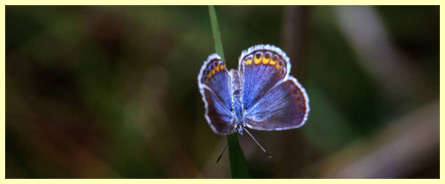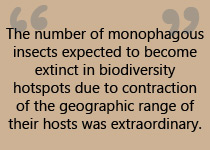
Who cares about insects? Aren’t they just agricultural pests, household nuisances, and harborers of disease? I surely hope that is simply an attempt at exaggeration or at best an antiquated notion. Insects are vital to ecosystem management and fill important environmental roles as pollinators, decomposers parasites, herbivores, predators, and prey. Additionally, as approximately 50% of insects are herbivorous they aid in supporting higher food chain levels and accelerate carbon and nitrogen cycles. Yet, the potential for multi-species extinction gets little press in the shadows of the cute and cuddly. And I’m not pointing any fingers because this is just a matter of fact and I’m guilty of it as well.
“In fact, in the last 600 years, the extinction of only 70 insect species has been recorded, a strikingly low figure compared with the number of recorded extinctions for vertebrates.”
So when I happened upon a publication foretelling of rampant insect doom as a result of (you guessed it) habitat loss, I just had to spread it around. In this particular study the author focused efforts on monophagous insects, which are those that depend on a single plant species for survival, in 34 biodiversity hotspots. These worldwide hotspots have been identified as conservation priorities, have at least 1500 endemic plant species, and have been the victim of habitat loss resulting in the disappearance of 70% or more of its original vegetation. Because monophagous insects rely on a single plant species, they are most vulnerable to the effects of habitat  degradation and loss. The hotspots contain over 150,000 endemic plants and it is estimated that they support between 5.3 and 10.7 monophagous insect species per plant species.
degradation and loss. The hotspots contain over 150,000 endemic plants and it is estimated that they support between 5.3 and 10.7 monophagous insect species per plant species.
“Monophagous insects are particularly susceptible to habitat loss because to survive without their hosts they would need to exhibit improbable evolutionary host shifts.”
If we are to assume that the insects will be unable to undergo an “improbable evolutionary host shift” ahead of the pace of plant and habitat loss currently exhibited in the hotspots, then extinction of these resources will be inevitable. And that is precisely what the author found after applying a species–area relationship (SAR) model, which is and has been used to predict decreases in species diversity with reductions in the geographic area of plants.
And the outcome of all that data, described as conservative results, is a total of 213,830 insects in danger of extinction if trends continue.
“The estimated range of 213,830–547,500 species extinctions is three to four orders of magnitude higher than the 70 insect species known to have become extinct globally in modern times, despite the fact that the model was intentionally fed with very conservative parameters. On average my results showed that one monophagous species became extinct when 37–94 square kilometers of habitat was lost.”
It’s so easy to forget that there is more to habitat loss than the disappearance of high profile mammals and birds, but an array of plants and hundreds of thousands of insect species we desperately need.
![]()
FONSECA, C. (2009). The Silent Mass Extinction of Insect Herbivores in Biodiversity Hotspots Conservation Biology DOI: 10.1111/j.1523-1739.2009.01327.x

[…] This post was mentioned on Twitter by RayBeckerman, journowl and John Peter Thompson, gemswinc. gemswinc said: RT @InvasiveNotes: RT @RayBeckerman: RT @journowl: over 200,000 species threatened with silent mass extinction http://bit.ly/bCPwQ […]
[…] This post was Twitted by ResearchBlogs […]
[…] […]
Hi – I am here visiting from CotS. I am glad you highlighted the importance of insects in our ecosystems, and the detrimental impact of their extinctions. I just read in a magazine last night about a bird species that has declined rapidly here in North America, and how the bird’s decline coincides with the simultaneous pesticide spraying of the pine beetles. Yikes.
.-= Amber Coakley´s last blog ..Dawn Dishwashing Liquid Triples Donation to IBRRC =-.
Hi Amber, thanks for visiting. It is my first time participating in the Carnival of the Spineless and so far I have found all the posts quite interesting. Can you pass along the name of the article/magazine as I’d love to check it out?
Those pesky hidden pesticide side effects in your example seem eerily similar to that experienced by DDT and bald eagles/brown pelicans. We don’t often realize the damage that our actions are causing until a species is in peril.
Here you go – Birder’s World, Dec 2009 – article about the decline of Evening Grosbeaks. But I was wrong about the pine beetle – it is the spraying of the spruce budworm (native) that has been suggested as a possible reason for dwindling numbers of Evening Grosbeaks.
.-= Amber Coakley´s last blog ..Wheel Bug! =-.
Thanks for checking on that Amber!